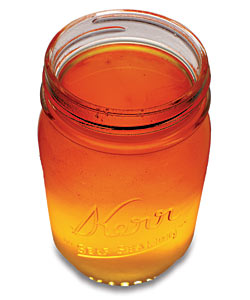
It’s official. I have become Winnie the Pooh. My world revolves around honey. Mornings, I slurp two spoonfuls for instant energy, my sweet surrogate for Starbucks. Later I spread it on kettle-cooked potato chips. I sip two spoons before bed for an all-natural nightcap. Not to mention my collection of honey pots. Honey pots. From France.
This is what happens when you spend your summer, as I did, milling around bee yards with amateur honey producers. You get your first taste of straight-from-the-comb honey—like sipping a Trappist ale after years of PBR—and then agree to become an unpaid serf just to taste a little more. For me, that meant driving 58 miles to Woodstock and getting past three Pentagon-worthy farm gates to a tiny collection of hives run by Corky Schnadt, vice president of the Northern Illinois Beekeepers Association.
It was a typical Yoda–Luke Skywalker relationship. He cared for one hive. I cared for three. But Schnadt did the hard part: constructing the hives. He ordered a package of productive Italian honeybees and picked it up at the post office. Then he secured a spot with plenty of sun and flowers. My task was easier: Keep the bees happy. In the spring, for example, it’s helpful to supply honeybees with sugar water until they can collect nectar in the summer. I could do that. I could also monitor honey production. I would put on a HAZMAT-like suit, pry open hives with a crowbar-style tool—the bees seal them with a gluey substance called propolis—and observe.
Worker bees suck nectar from flowers—it takes 800 bees their entire lives to produce one pound of honey—and fly it back to the hive. House bees put the nectar in a cell, add enzymes, fan away the moisture, and seal the honey behind a wall of wax, all, as my wife reminds me, to keep their queen satisfied.
My job was to maintain the status quo. Was the queen still alive? If not, beekeepers generally order a new queen, second-day air, to keep the hive going. Was it cold or rainy? If so, the bees would stay in the hive, and Schnadt and I would take a honey-filled frame from the center and replace it with an empty frame from the top, tricking the bees into thinking they had more work to do. Was the water content near the magic 18.5 percent? I tested that by smearing a little honey on a flute-shaped refractometer.
I also learned to harvest honey. Romantic? No. Willa Cather does not live here. In short, I turned Schnadt’s kitchen into a CSI set: plastic on the floors, booties on my feet. I put two dozen containers (the ones shaped like honey bears) in the dishwasher and pressed Start—by far the easiest part of the process. Then I scraped, using a honey scraper, which looks like a stainless steel hair pick. Off came the top layer of wax, a tenth of an inch thick, from the frame.
The unfiltered honey, popping with air bubbles, looked like glistening amber shot through with carbon dioxide. I ate it immediately, like cookie dough from the mixer, sticking my fingers inside the honeycomb and licking away. The honey, a product of the Woodstock bee yard’s dandelions and basswood trees, was light gold and tasted of fresh oranges and candied lemon. I slipped the wax reserves in my mouth too—Mother Nature’s own chewing gum. Later came extraction, filtering, and bottling, and then a big cleanup, but it was worth it. How else can you experience a buzz that lasts a lifetime?
For more information on making your own honey, visit the Northern Illinois Beekeepers Association at nibainfo.org.



